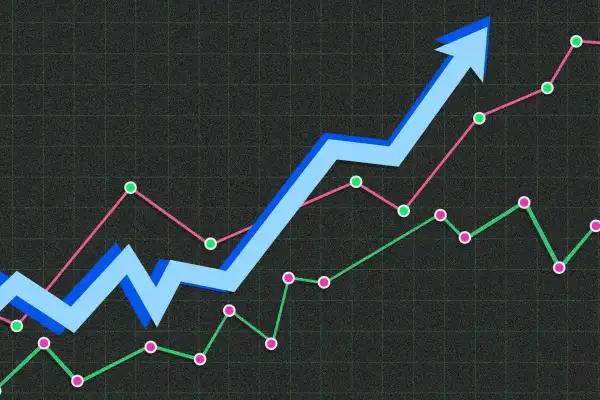Is 2025 the Year of 'Sector Investing?'
Money is not a client of any investment adviser featured on this page. The information provided on this page is for educational purposes only and is not intended as investment advice. Money does not offer advisory services.

With 2024 in the rearview mirror, investors who benefited from the S&P 500's 23.31% gain last year are hoping for more of the same in 2025. But with big banks forecasting tempered outlooks for the new year, pinpointing specific sectors within the market could offer greater returns than the broad indices.
In December, JPMorgan Research set a 2025 year-end price target of 6,500 for the S&P 500, representing just an 11.49% gain from current prices. In its report, the investment bank attributed numerous factors to the conservative estimate, including China's economic slowdown, higher-for-longer interest rates and the potential fallout of President-elect Donald Trump's trade and immigration policies.
In spite of last year's bull market, and in light of analysts' reserved projections, this year investors may want to focus on a handful of individual sectors in their attempts to outperform the broad index.
S&P 500 sectors to avoid
The S&P 500 — a stock market index that tracks the performance of 500 of the largest publicly traded companies listed on U.S. exchanges — spans 11 sectors. Numerous asset management companies, such as State Street and iShares by BlackRock, offer sector-specific exchange-traded funds (ETFs), which allow investors to hold shares of numerous companies operating within each individual sector.
Any given year, on a sector-by-sector basis, some of these ETFs outperform the broad index, and some underperform. The growth-focused information technology sector, for one, has outpaced the market five of the last six years. Meanwhile, industrials and materials — the latter of which posted the worst performance in 2024 — find themselves in the limelight less frequently.
The energy sector, for its part, is highly cyclical. In 2021 and 2022, energy received top marks by posting gains of 54.6% and 66.7%, respectively. But with record production and a looming oil and gas surplus, the sector finished fourth-worst in 2024. As a result, the Energy Select Sector SPDR Fund (XLE) only posted a gain of 3.89% in 2024, or roughly 20% less than the S&P 500. That macro environment could continue to weigh on the oil majors, most of which ended last year in the red.
Interest rate-sensitive sectors like real estate may also continue to struggle as the Federal Reserve has expressed concern about inflation creeping back up. While the Fed cut its benchmark rate by a full percentage point last in 2024, it is likely to embrace a higher-for-longer rate environment until the impacts of Trump's tariffs and immigration policy are fully understood.
Another underperformer in 2024 — consumer staples — is unlikely to post sizable returns this year. Louise Goudy Willmering, a chartered financial analyst and partner at Crewe Advisors, says two of the largest retailers in the U.S., Walmart and Costco, are showing signs of being overpriced.
"Each posted [sizable] returns in 2024," she says. "Their multiples seem a little stretched ... possibly creating a drag on the overall performance of the sector."
Consumer staples could also flounder this year if companies operating in that sector see their costs rise beyond what consumers are willing to pay. Grocery store stocks, for example, have proven capable of doing that in the past. Because consumer staples entail essentials like food and clothing, buyers' habits typically do not change with price adjustments. However, worsening inflation could cause shifts in consumer behavior, negating the sector's historical ability to rely on inelastic demand.
Despite these sectors' potential underperformance in 2025, in certain corners of the market, Willmering and other investment professionals see opportunity.
Expect more from 2024's best-performing sector
Last year, for the first time in 15 years, the communication services sector finished as the top performer in the S&P 500. Driven by the successes of telecom companies like T-Mobile and streaming services like Netflix, the sector gained nearly 34% in 2024, providing shareholders of the Communication Services Select Sector SPDR Fund (XLC) with a 10% advantage over the broad market.
This is one sector we can expect to remain strong, according to Andrew Evans, founder and CEO of Rossby Financial.
"As a people, we want more information faster and that only comes from the telecommunications sector," he says, pointing to the ubiquity of streaming services, podcasts and smart devices.
It's a sentiment shared by Willmering, who suggests the communications services sector has been bolstered by a handful of companies that have migrated from tech in recent years, helping the sector grow beyond legacy telecom companies.
"Gone are the days of the old telecommunications sector that was largely represented by AT&T and its 'baby bells,'" she says.
Since being rebranded as communication services in 2018, the sector is now home to former tech sector companies such as Alphabet and Meta, the first- and fourth- largest companies in the world by market cap. Willmering says this influx of tech, combined with streaming companies like Disney and Netflix, indicates strong performance from the sector in the year ahead.
A return of merger and acquisitions (M&A) activity would further bolster the communication services sector's odds of success this year. According to KPMG, one of the big four accounting services firms, in 2023, M&A activity fell to its lowest level in a decade with 2024 showing just a slight increase. However, with President Biden-appointed Lina Khan vacating her role at the Federal Trade Commission this month, it is expected to pave the way for less M&A scrutiny under Trump's second term.
"These [communication services] businesses are reinventing themselves and creating new opportunities," she says. "A more merger-friendly administration could allow for synergies that could be beneficial to investors again in 2025."
Tech will overcome obstacles
However, when it comes to antitrust practices in the technology sector, the president-elect has been a vocal critic. But in the ramp-up to January 20, numerous members of the Magnificent Seven donated millions to Trump's inauguration fund, including Alphabet, Apple, Meta and Microsoft.
Donations aside, support from the tech sector is unlikely to dissuade Trump from addressing anti-competitive behavior in Big Tech. "I don't see him being easily 'bought' by campaign donations," Evans says. "The donations could sway thoughts, but in the end, he will only pump the brakes if it suits [his] agenda."
Instead, Evans sees artificial intelligence being a major driver for the tech sector — and others — in 2025. "The prospect of what AI can do is going to continually fuel performance," he says. "Much like the birth of the internet or the building of the railroads, the infrastructure will take time. I believe we will see spin-off benefit in various other sectors because of [that] tech growth."
Those broad impacts and applications of AI in other sectors is a particularly valuable tailwind. "Technology is in the unique position of influencing how business will be done in virtually every economic sector going forward," Willmering says. "That demand is evolving to include yet-unimagined applications."
Lofty valuations, concerns around tariffs, interest rates and antitrust concerns will likely result in tech volatility this year, according to Willmering. But the sector still warrants a place in long-term portfolios, she argues, "even if it isn't in the top five performers of 2025."
Utilities could provide value
After finishing last among all sectors in 2023 with a -7.10% loss, the utilities sector bounced back last year, marginally trailing the broad market. This year, that momentum could continue as a result of AI spill-over from the tech sector.
"I think utilities stand to gain the most from technology growth," Evans says, specifically citing elevated power demand from AI chipmakers. "With power comes heat, then the need for cooling [and] maintenance on those systems. Amazon and Microsoft are actively buying power from various providers; it's not much of a stretch to think that Bezos would just go ahead and buy a few energy producers outright."
This past fall, Amazon offered $334 million to fund a multi-year feasibility study in partnership with Energy Northwest regarding the development of small four modular nuclear reactors. More broadly, last year Goldman Sachs found that AI is poised to drive a 160% increase in data center power demand.
However, like energy, the utilities sector is highly cyclical. And at current prices, it is also experiencing potentially inflated valuations, warns Willmering.
Even if utilities can't repeat its 23.4% gain from last year, there's still a chance the sector outperforms JPMorgan's forecasted 11.49% gain for S&P 500 through the rest of 2025. "Utilities could add diversification," she says, as the "sector is traditionally known for its steady growth and relatively stable dividend stream."
Regardless of which sectors outperform or underperform in 2025, most analysts agree on the direction the market is going: up and to the right. As Evans points out, "We live in a growth economy. Without growth, we cannot innovate, improve and better the overall standard of living for everyone."
More from Money:
I Let AI and My 5-Year-Old Pick My Stocks. Who Did Better?
4 Stock Market Predictions for 2025
This Is the Most Boring (but Effective) Way to Become a Millionaire

